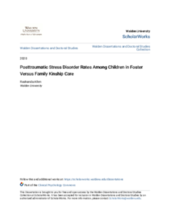Abstract
Children in foster care represent a highly traumatized population. However, trauma researchers studying this population have focused primarily on maltreatment rather than the full spectrum of posttraumatic stress disorder (PTSD) attributes and symptoms for children living in nonkinship foster homes versus kinship foster homes. The purpose of this study was to address this gap in the literature, as well as examine the benefits and limitations of children placed in kinship and nonkinship foster homes. Attachment theory was the theoretical framework. The research questions centered on the prevalence of specific types of posttraumatic stress symptoms for a sample of children living in both kinship and nonkinship foster homes, to determine which placement setting was more beneficial for children diagnosed with PTSD. This quasi-experimental study examined 221 foster parents who participated in an online survey. Research findings suggest that there was no significant differences among children in kinship and nonkinship foster homes and reported PTSD symptoms, however there was a significant difference among reported PTSD symptoms and psychotherapy received suggesting children who received mental health treatment services reported less PTSD symptoms Findings may contribute to social change by providing knowledge that Child welfare agencies can use to evaluate childhood PTSD and support foster care children's foster home placement stability, which may ultimately guide child welfare practice and policy.

